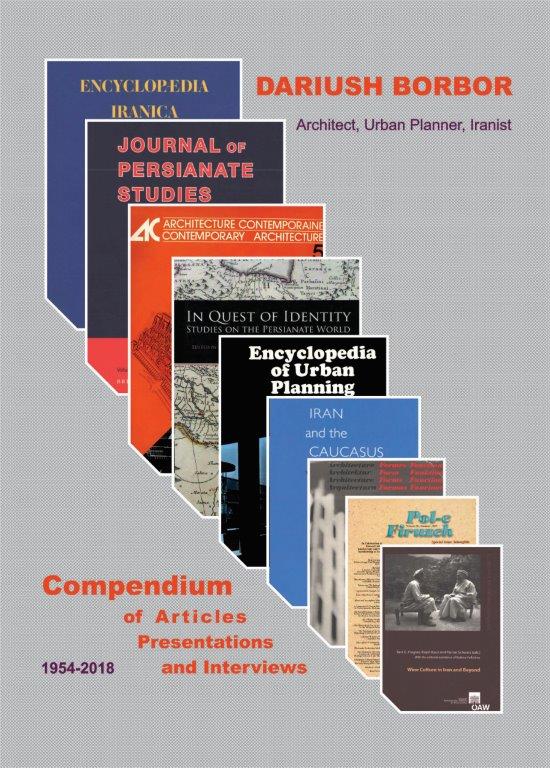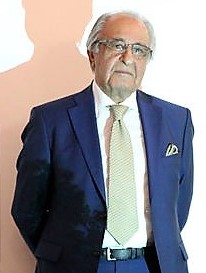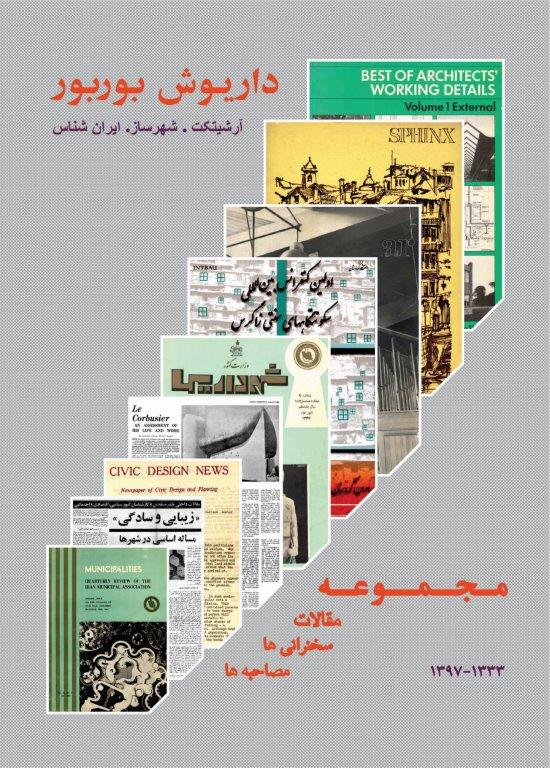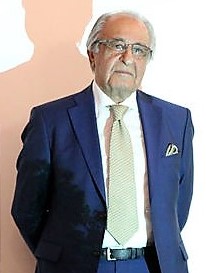Dariush Borbor Compendium of Articles, Presentations and Interviews 1954-2018, Sahab Geographic and Drafting Institute, Tehran, 2018, 728 pp. has just been published in hard cover. The articles are written in several languages, and the subject matter, deals with architecture, Urban Planning and Iranian Studies, including a complete bibliographical reference. Foreword by Ahmad Karimi-Hakkak, Distinguished Professor of Persian Language, Literature and Culture, University of Maryland MD.

distribution by: www.ketabsara.ir
داریوش بوربور مجموعه مقالات، سخنرانی ها و مصاحبه ها 1333-1397، موسسه جغرافیایی و کارتوگرافی سحاب، تهران، 1397، 728 صفحه به چاپ رسیده است. مقالات ارائه شده به چند زبان میباشند و مطالب آنها مربوط به معماری، شهرسازی و ایرانشناسی است. پیشگفتار از احمد کریمی حکاک، استاد ممتاز زبان، ادبیات و فرهنگ فارسی دانشگاه مریلند.
پخش کتاب: www.ketabsara.ir
About the Book
“Everybody knows that culture is a complex, multifarious concept, but few people contemplate all the diverse dimensions of a culture and still fewer produce works – informed opinions, in fact – in almost all the dimensions of a given culture. Dariush Borbor’s Compendium of Articles, Presentations and Interviews makes us aware of the many sides, not only of modern and contemporary Iranian culture, but of the world as he has experienced it. That multidimensionality is precisely what makes Dariush Borbor’s observations on making cultures, on cultures of making, and on culture in-the-making – all written with a sojourner’s mental agility and clarity, so compelling for us as to think of culture as a whole. Dariush Borbor’s Compendium of Writings encapsulates a life well and fruitfully lived. In that sense, it stands as a monument to one self-made man’s professional accomplishments as well as to the human capacity for inner and outer growth” (Ahmad Karimi-Hakkak, Los Angeles, October, 2017).
About the Author
Dariush Borbor is a multi-faceted Iranian architect, urban planner, designer, sculptor, painter, researcher, author and Iranologist. At the age of thirteen he went to the United Kingdom for his secondary schooling, after which he obtained his General Certificate of Education from University of Cambridge (1952), a Bachelor of Architecture (1958) and a Master of Civic Design (1959) both from the University of Liverpool. He then went to specialize on architecture of hot dry regions at the University of Geneva (1959).

He has an outstanding record as an entrepreneur: in 1963, he created his own office under the name of Borbor Consulting Architects, Engineers, City Planners; in 1976, he set up Sphere Consultants and proposed a comprehensive National Environmental Master plan for Iran; a few months prior to the 1978 Iranian Revolution, he moved to Paris where he founded the Borbor International Management Consultants (BIMC) that offered consultancy services in design, management and documentation to architects and urban planners; six years later, in 1984, he moved to Los Angeles where he was involved in architectural consultancy and research on Iranian and Persianate subjects; in 1992, he created the Research Institute and Library of Iranian Studies (RILIS) as a private, independent and non-profit institution dedicated to the promotion of research in the field of Iranian and Persianate studies with special emphasis on novel and creative subjects; in 2009, he initiated the Dariush Borbor Series of Seminars on Iranian Studies, for which distinguished scholars and specialists from outside of Iran have been invited.

He has won many competitions and received a number of international prizes and awards, including the Gold Mercury International Award from Italy (1976), the Pahlavi Royal Award (1978), and the 50 Outstanding Architects of the World from the Second Belgrade Triennial of World Architecture (1988).
He has been described by famous international critics as one of the most avnt-garde architects of the 20th century and the “father of modern urban planning” in Iran. He has made an enormous contribution to Iranian studies, particularly in history, ethnography and linguistics.




